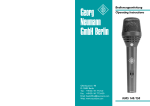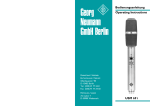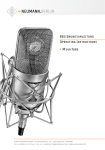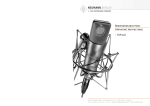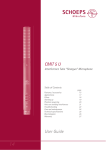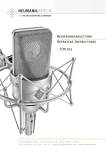Download Betriebsanweisung für das Kondensatormikrophon TLM 193
Transcript
68844 Betriebsanweisung für das Kondensatormikrophon TLM 193 Operating Instructions for the TLM 193 Condenser Microphone TLM ikkioopppü TLM August 1993 TLM 193 mit/with EA 193 1 Georg Neumann GmbH Berlin • Ollenhauerstr. 98 • D-13403 Berlin Irrtümer und technische Änderungen vorbehalten • Errors excepted, subject to changes • Printed in Germany Seite/Page 1. Kurzbeschreibung 1. A Short Description 2 2. Das Kondensatormikrophon TLM 193 2. The TLM 193 Condenser Microphone 3 2.1 Ausführungsform und Beschaltung des Mikrophonausgangs 2.2 Mikrophonkabel 3. Stromversorgung 3.1 Phantomspeisung 3.2 Betrieb mit Netzgeräten 3.2.1 Konventioneller Betrieb 3.2.2 Sammelspeisung 3.3 Batteriespeisung 3.4 Betrieb an unsymmetrischen oder mittengeerdeten Eingängen 2.1 Microphone Version and Output Wiring 2.2 Microphone Cables 3. Power Supply 3.1 Phantom Powering 3.2 ac Supply Operation 3.2.1 Conventional Operation 3.2.2 Central Powering 3.3 Battery Powering 3.4 Operation with Unbalanced or Center Tap Grounded Inputs 4 4 4 4 5 5 5 5 6 4. Technische Daten TLM 193 Schaltbild 4. TLM 193 Technical Specifications Circuit Diagram 7 8 5. Frequenzgänge und Polardiagramme 5. Frequency Responses and Polar Patterns 9 6. Zubehör 6. Accessories 10 1. Kurzbeschreibung 1. A Short Description Das Kondensatormikrophon TLM 193 ist ein Studiomikrophon mit der Richtcharakteristik Niere. The TLM 193 is a studio condenser microphone with cardioid polar pattern. Es zeichnet sich aus durch Its most important features are • besonders niedriges Eigengeräusch und höchste Aussteuerbarkeit, • especially low self noise level combined with highest output capability, • transformatorlose Schaltungstechnik, • transformerless circuit, • besonders saubere, freie und verfärbungsfreie Klangübertragung. Das Mikrophon hat einen symmetrischen, übertragerlosen Ausgang. Der 3polige Switchcraftstecker hat folgende Belegung: – Stift 1: 0 V/Masse – Stift 2: Modulation (+Phase) – Stift 3: Modulation (–Phase). Feldübertragungsfaktor 11 mV/Pa = – 39 dB re. 1V/Pa. Das Mikrophon wird mit 48 V, 2 mA phantomgespeist (DIN 45 596 bzw. IEC 268-15). • extraordinarily true sound transduction free of coloration. The microphone has a balanced, transformerless output. The 3-pin Switchcraft connector has the following pin assignments: – Pin 1: 0 V/ground – Pin 2: Modulation (+phase), – Pin 3: Modulation (–phase). The output sensitivity is 11 mV/Pa = – 39 dB re. 1V/ Pa. The microphone is phantom powered from 48 V, 2 mA (IEC 268-15/DIN45596). Die Einsprechrichtung ist seitlich, die Vorderseite wird durch das Neumann-Emblem gekennzeichnet. The axis of maximum sensitivity is at right angles to the main axis of the microphone. The front is designated by the Neumann insignia. Das Mikrophon wird in einem Holzetui zusammen mit dem Stativgelenk SG 193 geliefert. The microphone comes in a wooden case including the SG 193 swivel mount. 2 2. Das Kondensatormikrophon TLM 193 2. The TLM 193 Condenser Microphone Das Kondensatormikrophon TLM 193 ist ein Studiomikrophon der Serie fet 100 mit der Richtcharakteristik Niere. The TLM 193 Condenser Microphone is a studio microphone of the fet 100 series with a cardioid polar pattern. Die Buchstaben TLM stehen für „Transformatorloses Mikrophon“. Der zur Leistungsanpassung der Mikrophonausgangsspannung an die Betriebsspannung üblicherweise verwendete Übertrager ist im TLM 193 durch eine elektronische Schaltung ersetzt, die - wie ein Übertrager - für eine gute Unsymmetriedämpfung sorgt. Daher werden Störsignale, die auf die symmetrische Modulationsleitung einwirken, wie gewohnt unterdrückt. Die Eigenstörspannung des TLM 193 konnte gegenüber vergleichbaren Mikrophontypen stark gesenkt werden, wobei das Mikrophon Schalldruckpegel von 140 dB unverzerrt überträgt und einen Dynamikumfang von 130 dB zur Verfügung stellt (nach DIN/ IEC 651). Das Kondensatormikrophon TLM 193 wird von der Seite besprochen. Seine Vorderseite ist durch das Neumann-Emblem gekennzeichnet. The letters TLM stand for Transformerless Microphone. The transformer which used to couple a microphone’s output to the supply voltage, has been replaced in the TLM 193 by an electronic circuit which, like a transformer, maintains the excellent common mode rejection (CMR). Interference induced in the balanced modulation line is therefore suppressed as usual. The self-noise level of the TLM 193 is much lower than that of comparable microphone models while its overload capability extends to 140 dB SPL, providing a dynamic range of 130 dB (DIN/IEC 651). The TLM 193 has its axis of maximum sensitivity arranged radially; i.e. at right angles to the axis of its body. The microphone front is marked by the Neumann insignia. Its grille houses a dual-membrane capsule with a particularly linear frequency response. Die im Drahtgeflechtkorb des Mikrophons befindliche Doppelmembrankapsel besitzt einen besonders ebenen Frequenzgang, und zwar nicht nur, wie vielfach üblich, für den von vorn einfallenden Schall, sondern auch für Schall, der seitlich innerhalb eines Winkelbereichs von mehr als ± 100° einfällt. Daher verlaufen auch der Diffusfeld-Frequenzgang des TLM 193 bis 10 kHz parallel zu der in Abschnitt 5 gezeigten 0°-Grad-Kurve. Praktisch betrifft das die indirekt über Reflektionen im Aufnahmeraum zum Mikrophon gelangenden Schallanteile. Damit wird auch ein etwa mitaufzunehmender Nachhallschall durch das Mikrophon in seinem Klangcharakter nicht verändert. Dies unterscheidet das TLM 193 von einem Druckempfänger mit Kugelcharakteristik, bei dem Diffusund Freifeldfrequenzgang nicht übereinstimmen können. This linearity applies not only for sound coming from the front but also for sound incidence angles up to ± 100°, where the frequency response is flat up to 10 kHz. In view of these facts it follows that the diffusefield response - namely the response in a lively acoustic environment with reflections entering the microphone from all directions - will also be linear. This is of vital importance in the recording environment and insures that the tone color of reverberant sound will not be altered by the microphone. This is in sharp contrast to an omni-directional pressure transducer in which the diffuse- and direct-field responses never match! Da zum Erreichen der genannten Mikrophoneigenschaften keine Resonanzwirkungen genutzt werden, ist das Impulsverhalten des Mikrophons ausgezeichnet, und es vermag alle Ausgleichsvorgänge in Musik und Sprache unverfälscht zu übertragen. The entire exposed surface of the capsule, including the membranes, is at ground potential making it immune to electric as well as atmospheric conditions and dirt. Die gesamte Oberfläche der Kapsel einschließlich der Membranen liegt auf Massepotential und ist daher unempfindlich gegen elektrische und atmosphärische Einflüsse und gegen Schmutz. Die Kapsel ist zum Schutz gegen Körperschallübertragung elastisch gelagert. No resonance effects are used to obtain the characteristics mentioned above. As a consequence, the microphone features excellent transient behaviour and transmits all transient phenomena of music or voice without distortion. In order to protect the capsule from mechanical shock transmission it is elastically suspended. As the TLM 193's amplifier is linear up to 20 Hz, extremely low frequency signals can be transmitted without distortion as well. On the other hand the microphone is therefore more sensitive to low-frequency noises as structure-borne or wind and pop disturbances. For 3 Da der Verstärker des TLM 193 bis 20 Hz linear verläuft, können auch extrem niederfrequente Signale unverfälscht übertragen werden. Andererseits ist das Mikrophon dadurch empfindlicher für tieffrequente Störungen wie Körperschall oder Popp- und Windgeräusche. Daher empfiehlt sich eventuell die Verwendung der Elastischen Aufhängung EA 193, des Popschirms PS 10 oder PS 20 oder des Windschutzes WS 89 (s. Kapitel 6, Zubehör). specific applications it is therefore recom-mendable to use protective accessories as the EA 193 elastic suspension, the PS 10 or PS 20 pop screens or the WS 89 windscreen (s. chapter 6, Accessories). 2.1 Ausführungsformen und Beschaltung des Mikrophonausgangs 2.1 Microphone Version and Output Wiring Das Mikrophon TLM 193 besitzt eine schwarzmatte Oberfläche und ist mit einem 3poligen XLR-Steckverbinder ausgerüstet. Die Zuordnung der Mikrophonanschlüsse entspricht DIN 45 599, Kennzeichen „I“ bzw. IEC268-12 (pin. conn. 130-x-IEC 02): Die Modulationsadern liegen an Stift 2 und 3, die Abschirmung an Stift 1. Bei einem Schalldruckanstieg vor der Mikrophonmembran tritt an Stift 2 eine positive Spannung auf. The TLM 193 microphone has a matt black finish and is equipped with a 3-pole XLR connector. 2.2 Mikrophonkabel 2.2 Microphone Cables Für das TLM 193 stehen folgende Kabel zur Verfügung: IC 3 mt 10 m langes Mikrophonkabel mit 3poligen XLR-Steckverbindern. Es kann auch als Verlängerungskabel verwendet werden. IC 4 mt 10 m langes Mikrophonkabel mit dreh- und schwenkbarem Stativgelenk (3pol. XLRSteckverbinder mit Überwurfmutter). Bei Verwendung des Kabels IC 4 mt kann das Mikrophon entweder auf ein Stativ geschraubt werden, oder in Verbindung mit der Neigevorrichtung MNV 87 mt (s. Kapitel 6, Zubehör) am Kabel von der Decke abgehängt und geneigt werden. Andere Kabellängen sind auf Wunsch lieferbar. Das Mikrophon ist besonders unempfindlich gegen kapazitive Belastung. TIM- und Frequenzgangverzerrungen werden daher auch bei Verwendung sehr langer Kabel nicht hervorgerufen. Microphone wired per IEC 268-12 (pin conn. 130-x-IEC 02) or DIN 45 599 I, respectively: Modulation is connected to pins 2 and 3, the shield to pin 1. A sudden sound pressure rise in front of the membrane causes a positive voltage to appear at pin 2. ThefollowingcablesareavailablefortheTLM 193 microphone: IC 3mt 10 m (33 ft.) microphone cable with 3-pole XLR connectors. May also be used as extension cable. IC 4 mt 10 m (33 ft.) microphone cable with rotary swivel mount and 3-pole XLR connectors with coupling ring. When using the IC 4 mt cable, the microphone can be either attached to a stand or, in combination with the MNV 87 Auditorium Hanger (s. chapter 6, Accessories), suspended from the ceiling and tilted. Special cable lengths can be made to order. The microphone is highly insensitive to capacitive loading. As a result, even very long cable runs do not cause either TIM or frequency distortion. Der Ausgang eines Phantomspeisegerätes darf auch auf bereits anderweitig phantomgespeiste Mi- krophoneingänge gesteckt werden. 3. Power Supply 3.1 Phantomspeisung 3.1 Phantom Powering Die Mikrophone der Serie fet 100 werden mit 48 V phantomgespeist (P 48, DIN 45 596/IEC 268-15). Bei der Phantomspeisung fließt der Speisestrom vom positiven Pol der Spannungsquelle über die elektri- The fet 100 Series microphones are phantom-powered at 48 V (P 48, DIN 45 596 / IEC 268-15). With phantom powering the dc from the positive supply terminal is divided via two identical resistors, one half of the dc flowing through each audio (modulation) conductor to the microphone, and returning to the voltage source via the cable shield. Phantom powering provides a fully compatible connecting system, since no potential differences exist between the two audio conductors. Studio outlets so powered will therefore also accept dynamic microphones and ribbon microphones as well as the modulation conductors of tube-equipped condenser microphones without the need to switch off the dc supply voltage. No harm is done even if a phantom power supply is connected to an outlet which is phantom powered from another source. 3.2 Betrieb mit Netzgeräten 3.2 ac Supply Operation 3.2.1 Konventioneller Betrieb 3.2.1 Conventional Operation Für die Stromversorgung des TLM 193 sind prinzipiell alle P 48-Netzgeräte entsprechend DIN 45 596 bzw. IEC 268-15 geeignet, die mindestens 2,4 mA je Kanal abgeben. All P 48 power supplies according to IEC 268-15 and DIN 45 596, providing at least 2.4 mA per channel, are suitable in principle for powering the TLM 193 microphone. Das Neumann P 48-Netzgerät hat die Bezeichnung N 48 i-2. Es ist zur Stromversorgung zweier MonoKondensatormikrophone oder eines Stereomikrophons mit 48 V ± 1 V, maximal 2 x 5 mA, geeignet (siehe auch Neumann-Druckschrift 10000 821.. „48 V-Phantomspeisegeräte“). The Neumann P 48 power supply unit bears the designation N 48 i-2. It is designed to power two mono condenser microphones or one stereo microphone at 48 V ± 1 V, max. 2 x 5 mA. (See also Neumann bulletin No. 10000821.. “Phantom 48 Vdc Power Supplies”). Die Zuordnung der Mikrophonanschlüsse und die Polarität der Modulationsadern ist am Ausgang der Speisegeräte die gleiche wie am Mikrophon. Modulation polarity at the power supply units is identical with that at the microphone. 3.2.2 Sammelspeisung 3.2.2 Central Powering Werden mehrere Mikrophone betrieben, so können diese über eine feste Verdrahtung aus einem Gerät für Sammelspeisung versorgt werden (siehe auch Neumann Druckschrift 10000 817.. „Sammelspeisung“): N 448 A Netzgerät, 48 V, Stromabgabe maximal 100 mA, Steckkarte im Europaformat. When more than two microphones are to be powered, a permanently wired central powering system is recommended. See Neumann bulletin No. 10000 817.. “Central Powering”: N 448 A ac mains operated central powering unit, 48 V, maximum current output 100 mA. Plug-in PC board GW 2448 KA dc-to-dc converter using 24 Vdc operating voltage. Maximum current output 50 mA. Plug-in PC board . GW 2448 KA 3. Stromversorgung 4 sche Mitte der beiden Modulationsadern zum Mikrophon. Er wird hierzu über zwei gleichgroße Widerstände beiden Tonadern gleichsinnig zugeführt. Die Rückleitung des Gleichstroms erfolgt über den Kabelschirm. Zwischen beiden Modulationsadern besteht also keine Potentialdifferenz. Daher ist mit der Phantomspeisung eine kompatible Anschlußtechnik möglich: Auf die Anschlußdosen können wahlweise auch dynamische Mikrophone oder Bändchenmikrophone sowie die Modulationskabel röhrenbestückter Kondensatormikrophone geschaltet werden, ohne daß die Speisegleichspannung abgeschaltet werden muß. Gleichspannungswandler für den Anschluß an eine 24 V-Stromversorgung. Stromabgabe maximal 50 mA, Steckkarte im Europaformat. 3.3 Batteriespeisung 3.3 Battery Powering Steht keine Netzspannung zur Verfügung, kann die Speisung mit einem der Geräte BS 48 i (für ein Mikrophon) oder BS 48 i-2 (für zwei Mikrophone) erfolgen. If a mains power source is not available, power can be supplied by one of the units BS 48 i (for one microphone) or BS 48 i-2 (for two microphones). 5 Beide Geräte liefern 48 V ± 1 V, maximal je 5 mA, und werden jeweils von einer 9 Volt-Blockbatterie Typ IEC 6 F 22 gespeist. Ein Mikrophon der Serie fet 100 kann mit einem BS 48 i ca. 20 Stunden betrieben werden (siehe auch Neumann-Druckschrift 10000821.. „48 V-Phantomspeisegeräte“). Die Zuordnung der Mikrophonanschlüsse und die Polarität der Modulationsadern ist am Ausgang der Speisegeräte die gleiche wie am Mikrophon. 3.4 Betrieb an unsymmetrischen oder mittengeerdeten Eingängen Both units supply 48 V ± 1 V, at 5 mA maximum, and are powered by a 9-volt monobloc battery Type IEC 6 F 22. A microphone of the fet 100 Series can be operated for approx. 20 hours on a BS 48 i. 4. TLM 193 Technical Specifications 1 Pa = 10 µbar 0 dB = 20 µPa 1 Pa = 10 µbar 0 dB = 20 µPa See Neumann bulletin 10000821... “Phantom 48 Vdc Power Supplies”. Modulation polarity at the power supply is identical with that at the microphone. 3.4 Operation with Unbalanced or Center Tap Grounded Inputs Die 48 V-Phantomspeisegeräte BS 48 i, BS 48 i-2 The 48 V phantompowering units BS 48 i, BS 48 i-2 and N 48 i-2 have dc-free outputs, so that no transformer und N 48 i-2 haben gleichspannungsfreie Ausgänge, is required for connecting to an unbalanced input. so daß für den Anschluß an einen unsymmetrischen Eingang kein Übertrager erforderlich ist. In the case of the TLM 193 condenser microphone pin Beim TLM 193 ist Pin 2 die „heiße Phase“, und Pin 3 2 is the ”hot phase”, and pin 3 must be connected to muß für unsymmetrische Eingänge an Masse gelegt earth (see Fig. 1). werden (siehe Abbildung 1). In the case of many other phantom powering units (exBei vielen anderen als den o.g. Phantomspeisegeräcept those mentioned ten liegen nicht nur die Modulaabove), not only the modutionsleitungen zum Mikrophon lation leads to the microauf dem Potential der Speisephone, but also the outgoing spannung von + 48 V, sondern modulation leads from the auch die vom Speisegerät abgepowering unit, are at the pohenden Modulationsleitungen. Für tential of the feed voltage die in der Studiotechnik allgemein (+ 48 V). üblichen symmetrischen und erdThis is of no significance for freien Verstärker- und MischpulAbbildung / Figure 1 the balanced, floating ampliteingänge ist dies ohne Bedeufier and mixing console intung. puts in general studio use. Dagegen wird die Speisespannung beim Anschluß an On the other hand, the feed voltage will be short-circuited einseitig oder mittengeerdete Verstärkereingänge when connected to single-sided or center tap grounded kurzgeschlossen, und es ist kein Betrieb möglich. amplifier inputs, and no operation will be possible. Dann bestehen folgende Lösungsmöglichkeiten: This can be circumvented a) In mittengeerdeten Geräas follows: ten mit Eingangsübertraa) In center tap grounded ger (z.B. einige NAGRAequipment with input Geräte) kann die betreftransformer (e.g. some fende Erdverbindung fast NAGRA units), the immer ohne Nachteile für earth lead can almost die Funktion des Gerätes always be disconnectaufgetrennt werden. ed without affecting the b) In jede abgehende Modufunction of the equiplationsleitung kann zur ment. Abblockung der 48 Vb) In every outgoing modGleichspannung eine RCulation lead, an RC netKombination eingefügt work can be incorporatwerden (siehe Abbildung 2 ed to block the 48 Vdc und Neumann-Information voltage (See Fig. 2 and Nr. 84 221). Neumann-Information Abbildung / Figure 2 no. 84 222). 6 4. Technische Daten TLM 193 Akustische Arbeitsweise Druckgradientenempfänger Richtcharakteristik Übertragungsbereich Feldübertragungsfaktor 1) Niere 20 Hz...20 kHz 11 mV/Pa ± 1 dB Nennimpedanz 50 Ohm Nennabschlußimpedanz 1000 Ohm Geräuschpegelabstand (bezogen auf 1 Pa bei 1kHz, DIN 45 590/DIN 45 405, CCIR 468-3) Ersatzgeräuschpegel (DIN 45 590/DIN 45 405, CCIR 468-3) A-bewerteter Äquivalentschalldruckpegel bedingt durch innere Störquellen (DIN/IEC 651) Grenzschalldruckpegel für 0,5% Klirrfaktor 2) Max. Ausgangsspannung dabei Abmessungen cardioid Frequency range Sensitivity 1) 20 Hz...20 kHz 11 mV/Pa ± 1 dB Rated impedance 50 ohms Rated load impedance 1000 ohms 73 dB 21 dB Equivalent noise level (DIN 45 590/ DIN 45 405, CCIR 468-3) 21 dB 10 dB A-weighted equivalent SPL due to inherent noise (DIN/IEC 651) 10 dB 48 V ± 4 V 2,4 mA Gewicht Directional pattern 73 dB 2540 mV Stromaufnahme pro Kanal Pressure gradient transducer S/N ratio (related to 1 Pa at 1 kHz, DIN 45 590/ DIN 45 405, CCIR 468-3) 140 dB = 200 Pa Phantomspeisespannung (P 48, DIN 45 596, IEC 268-15) Acoustical oper. principle ca. 480 g Max. SPL for less than 0.5% THD 2) maximal output voltage 140 dB = 200 Pa 2540 mV Phantom powering (P 48, DIN 45 596, IEC 268-15) 48 V ± 4 V Current consumption per channel 2.4 mA Weight Dimensions approx. 480 g 49 mm x 175 mm 49 mm x 175 mm 1) bei 1 kHz an 1 kOhm Nennabschlußimpedanz. 1 Pa = 94 dB SPL. 1) at 1 kHz into 1 kOhm rated load impedance. 1 Pa = 94 dB SPL. 2) Klirrfaktor des Mikrophonverstärkers bei einer Eingangsspannung, die der von der Kapsel beim entsprechenden Schalldruck abgegebenen Spannung entspricht. 2) THD of microphone amplifier at an input voltage equivalent to the capsule output at the specified SPL. 7 5. Frequenzgang und Polardiagramm Frequency Response and Polar Pattern dB +10 0 -10 -20 20 50 100 200 500 1k 5k 2k 10k 20k Hz 0 ° 0 315 ° 45 ° 5 10 15 20 dB 270 ° 225 125 Hz 250 Hz 500 Hz 1 kHz 8 90 ° 135 ° 180 ° ° 2 4 8 16 kHz kHz kHz kHz 9 6. Zubehör 6. Accessories Die meisten Tisch- und Fußbodenständer etc. haben ein 5/8″ -27-Gang-Gewinde. Ein Reduzierstück für 3/8″ - und 1/2″ -Gewindeanschluß wird mitgeliefert. Es ist auch einzeln erhältlich (Bestell-Nummer: 8421400180). Most of the table stands, floor stands, etc. have a 5/8″ -27 thread. An adapter (Parts Catalog No. 8421400180) can be supplied to provide campatibility with 3/8″ and1/2″ threads. Tischständer Table Stands MF 3 Best.-Nr. 12442 001 Tischständer mit Eisenfuß, 1,6 kg schwer, Ø 110 mm. Der Ständer ist schwarzmatt lackiert und steht gleitfest auf einer Moosgummi-Scheibe. Ein umwendbarer Gewindezapfen ermöglicht die Verwendung für zwei Gewindeanschlußnormen (1/2″ bzw. 3/8″ ). Mit Hilfe des mitgelieferten Reduzierstückes ist die Anpassung an ein 5/8″ -27-Gang Gewindeanschluß möglich. MF 3 Cat.-No. 12442 001 Table stand with iron base, 110 mm (43.3) in diameter, 1.6 kg (3.53 lbs). The table is matt black finish and non-slip due to a rubber disc attached to the bottom. A reversible stud permits use of two threads standards (1/2″ and 3/8″ ). An adapter is supplied to provide compatibility with 5/8″ -27 thread. MF 4 Best.-Nr. 12447 001 Tischständer, Grauguß, 2,6 kg, 160 mm . Schwarzmatt lackiert, umwendbarer Gewindezapfen 3/8″ und 1/2″. MF 4 Cat.-No. 12447 001 Table stand grey cast iron, 2.6 kg (6 lbs.), 160 mm (6.5″ ) in diameter, matt black lacquer. Reversible thread stud with 1/2″ or 3/8″ thread. Fußbodenständer Floor Stands M 214/1 Best.-Nr. 12410 001 Fußbodenständer, klappbar, sehr standfest durch ausladende Fußkonstruktion. Die Länge des zusammengeklappten Ständers beträgt 1,2 m, das Gewicht 6 kg. Die maximale Höhe ist 2,2 m, die minimale Höhe 1,3 m. Die Fußkonstruktion ist schwarz lackiert, das ausziehbare Rohr ist vernikkelt. Es hat einen 1/2″ -Gewindezapfen zur Befestigung eines Mikrophons oder des Galgenaufsatzes M 212 c. Der Fußbodenständer kann komplett mit Galgenaufsatz unter der Bezeichnung M 212 geliefert werden. Diese Stativkombination kann für alle Mikrophone verwendet werden. M 214/1 Cat.-No. 12410 001 Extremely stable folding stand. Length when folded 1.2 m (4 ft.). Weight 6 kg (13 lbs.). Maximum height 2.2 m (87″ ), minimal working height 1.3 m (51″ ). The tripod is black lacquer finished. The height-adjustable upright is nickel-plated and has a 1/2″ thread stud for mounting a microphone or the M 212 c boom attachment. Floor stand and boom attachment together bear the designation M 212. This unit may be used for all microphones. Galgenaufsatz M 212 c Best.-Nr. 12410 004 Galgenaufsatz für Mikrophonstativ M 214/1. Die seitliche Ausladung ist zwischen 1,1 m und 1,8 m einstellbar. Mit Gegengewicht für schwere Mikrophone. 3/8″ -Gewindezapfen zur Befestigung des Mikrophons. Gewicht: 4,3 kg. Die Oberfläche ist vernickelt bzw. schwarz lackiert. M 212 c Boom Attachment Cat.-No. 12410 004 Boom attachment for M 214/1 folding floor stand. Boom extends from 1.1 m to 1.8 m (43.3″ to 71″ ). With counterweight for heavy microphones. 3/8″ thread stud for mounting microphone. Weight 4.3 kg (9.7 lbs.). Nickelplated with black lacquer finish. 10 MF 3 MF 4 M 214/1 M 212 c 11 M 31 Best.-Nr. 12407 001 Fußbodenständer mit dreibeinigem, hammerschlageffektlackiertem Gußfuß, Gewicht: 4 kg. Rohr vernikkelt und zur Trittschalldämmung in einer Gummimuffe gelagert. Höhe: variabel von 1,1 m bis 1,8 m. Der Ständer besitzt einen Gewindezapfen mit 3/8″ Gewinde zur Befestigung des Mikrophons. Auf Anfrage kann dieser Ständer gegebenenfalls auch mit geringerer Höhe sowie als „mt“-Version mit dunkel mattiertem Rohr geliefert werden. M 31 Cat.-No. 12407 001 Floor stand with tripod, hammertone lacquered castiron base. Weight 4 kg (8.8 lbs.). Nickel-plated tube shock mounted for dampening structure-borne vibrations. Height adjustable from 1.1 m to 1.8 m (43.3″ to 71″ ). The stand is equipped with a thread stud having a 3/ 8″ thread for mounting the microphone. Shorter versions as well as an “mt” version with a matt black tube are also available. M 32/S Best.-Nr. 12408 001 Fußbodenständer, klappbar, Gewicht: 2,7 kg. Die Länge des zusammengelegten Ständers beträgt 0,9 m, seine maximale Höhe ist 1,8 m. Der Ständer ist vernickelt und besitzt einen Gewindezapfen 3/8″ zur Mikrophonbefestigung. M 32/S Cat.-No. 12408 001 Folding floor stand, weight 2.7 kg (6 lbs.). The length of the folded stand is 0.9 m (35″ ), its maximum height is 1.8 m (71″ ). The stand is nickel-plated and has a threaded 3/8 stud for microphone mounting. M 35 Best.-Nr. 12409 001 Sehr stabiler Klappständer, vernickelt. Gewicht: 9 kg. Maximale Höhe 5 m, minimale Arbeitshöhe 1,40 m, Länge in zusammengelegtem Zustand 1,65 m. Der Ständer besitzt einen Gewindezapfen 1/2″ zur Befestigung des Mikrophons. M 35 Cat.-No. 12409 001 Extremely stable folding stand, nickel-plated, weight 9 kg (19.8 lbs.). Maximum height 5 m (16 ft), minimum working height 1.4 m (55″ ), length when folded 1.65 m (65″ ). The stand has a 1/2″ thread stud for mounting the microphone. G 35 Best.-Nr. 12409 003 Galgenaufsatz für M 35, vernickelt. Gewicht: 8 kg. Seitliche Ausladung bis 2,5 m. Mit schwenkbarem Gewindezapfen 3/8″ . G 35 Cat.-No. 12409 003 Boom attachment for M 35, nickel-plated, weight 8 kg (17.7 lbs.). Boom extends side-ways to 2.5 m (8′ 3″ ). With 3/8″ stud on swivel joint. M 135 Best.-Nr. 12409 002 wie M 35, jedoch mit maximaler Höhe 10 m. Minimale Arbeitshöhe 1,60 m, Länge in zusammengelegtem Zustand 1,75 m. Gewicht: 27,5 kg. M 135 Cat.-No. 12409 002 Similar to M 35, but with a maximum height of 10 m (32′ 10″ ). Minimum working height 1.60 m (63″ ). Length when folded 1.75 m (69″ ). Weight 27.5 kg (60.6 lbs.). Studiogalgen Studio Booms M 184 Best.-Nr. 12411 001 Studiogalgen, fahrbar, dreibeiniger Gußfuß, schwarz krepplackiert, mit Gummirollen. Rohr vernickelt und schwarz lackiert. Mittlere Höhe verstellbar von 1,8 m bis 2,5 m. Seitliche Ausladung 1,2 m bis 2,9 m, maximale Höhe bei Schrägstellung 4,5 m. Schwenkbarer Gewindezapfen 1/2″ zur Mikrophonbefestigung. Gewicht: ca. 60 kg. M 184 Cat.-No.12411 001 Studio boom, on rubber casters, three-legged castiron base, black wrinkle finish lacquer, nickel-plated tube black lacquered. Adjustable from 1.8 m to 2.5 m (6 ft. to 8 ft.). Boom extends from 1.2 m to 2.9 m (4 ft. to 10 ft.), maximum height when set at an angle approx. 4.5 m (14′ 9″ ). 1/2″ thread swiveling stud for microphone mounting. Weight approx. 60 kg (132 lbs.). 12 M 184 M 35, G 35 M 31 M 32/S 13 Stativgelenk SG 193 Best.-Nr. 68843 (gehört zum Lieferumfang) (o. Abb.) Das Stativgelenk SG 193 kann an das Bodenstück des Mikrophons TLM 193 angeschraubt werden und dient zur Befestigung dieses Mikrophons am Stativ bei Verwendung des Kabels IC 3 mt. Es hat einen Gewindeanschluß 5/8″ -27-Gang zur Verbindung mit dem Stativgewindezapfen. Ein Reduzierstück zum Anschluß an 1/2″ - und 3/8″ Gewindezapfen wird mitgeliefert. SG 193 Swivel Mount Cat.-No. 68843 (standard accessory) (w/o picture) The SG 193 swivel mount is used to fasten the TLM 193 to a stand when connected with an IC 3 mt cable. The swivel mount has a 5/8″ -27 thread for mounting on a microphone stand or boom. A thread reducer for mounting on a 1/2″ or 3/8″ studs is included. Mikrophon-Neigevorrichtung MNV 87 mt Best.-Nr. 11435 004 Die Mikrophonneigevorrichtung MNV 87 mt besteht aus einer Kabelhalterung und einen Gewindezapfen. Sie wird in das Stativgelenk des Kabels IC 4 geschraubt (s. Kapitel 2.3) und ermöglicht dann die Einstellung der Mikrophonneigung bei frei am Kabel hängendem Mikrophon. Die Zugbelastbarkeit des Kabelmaterials und der Verbindungen ist dafür inkl. Sicherheitsfaktor genügend hoch. Gewinde: 1/2″ - oder 5/8″ -27-Gang. MNV 87 mt Auditorium Hanger Cat.-No. 11435 004 The MNV 87 mt auditorium hanger consists of a cable clamp and a stud with which it is screwed into the swivel mount of the IC 4 cable (see chapter 2.3). The microphone can then be tilted as needed because it is freely suspended from its own cable. The tensile stress of the cable material and the connections are sufficient high including the security factor. Available with 1/2″ or 5/8″ -27 thread stud. Elastische Aufhängung EA 193 (Abb.: s. Titelseite) Best.-Nr. 08404-N Um sehr starke Erschütterungen vom Mikrophon fernzuhalten, empfiehlt sich die Verwendung der elastischen Mikrophonaufhängung EA 193. Sie besitzt einen schwenkbaren Gewindeanschluß 5/ 8″ -27-Gang und ein Reduzierstück zur Verbindung mit 1/2″ - und 3/8″ -Gewindezapfen. Das Mikrophon wird in der EA 193 mit Hilfe einer zugehörigen Rändelmutter festgeschraubt und mit einem 3poligen XLR-Kabel angeschlossen. EA 193 Elastic Suspension (picture: s. title page) Cat.-No. 08404-N The use of the EA 193 elastic suspension is recommended to prevent the microphone from being exposed to mechanical vibration caused by structure borne shock waves. It has a 5/8″ -27 female thread. A thread reducer for 1/2″ or 3/8″ studs is included. The microphone is fastened to the EA 193 with the included knurled screw and connected with a standard 3-pole XLR cable. Holzschatulle für TLM 193 (gehört zum Lieferumfang) Wooden Case for TLM 193 (standard accessory) MNV 87 mt (o. Abb.) (w/o picture) Schatulle mit Metallverschlüssen und Formteileinlage. Case with metal locks and supportive formed insert. Windschutz WS 89 Best.-Nr. 12403 001 Zum Vermeiden von Störgeräuschen, die bei Nahbesprechung, Windeinfluß oder z.B bei schnellem Schwenken des Mikrophongalgens auftreten können, sind Windschutzeinrichtungen aus offenporigem Polyurethanschaum lieferbar. Diese Windschutzeinrichtungen erzeugen keine störenden Resonanzen und beeinflussen den Frequenzgang des Übertragungsmaßes nur geringfügig. Dämpfung des Windgeräusches: ca. 27 dB, gemessen in verwirbelter Luftströmung der Geschwindigkeit 20 km/h, erzeugt von einer geräuschlos arbeitenden WS 89 Windscreen Cat.-No. 12403 001 Open-cell polyurethane foam windscreens are available to guard against disturbances that may be caused by wind, close-talking applications, or rapid boom movements. These windscreens have no disturbing resonances and only slightly affect the frequency response. Wind noise suppression: approx. 27 dB measured in pulsating air currents produced by a noiseless wind machine at 20 km/h (without electrical filter). 14 WS 89 15 Popschirme PS 10 und PS 20 PS 10 and PS 20 Pop Screens PS 10 10 cm Ø Best.-Nr. 13405 001 PS 10 10 cm Ø Cat.-No. 13405 001 PS 20 20 cm Ø Best.-Nr. 13405 002 PS 20 20 cm Ø Cat.-No. 13405 002 Die Popschirme PS 10 und PS 20 bieten einen sehr wirksamen Schutz vor den sogenannten Popgeräuschen. Sie bestehen aus einem runden dünnen Holzrahmen, der beidseitig mit schwarzer Gaze bespannt ist. Der um ca. 230° schwenkbare Stativaanschlußstutzen hat 5/8″ -27-Gang-Innengewinde und mit Reduzierstück für entsprechende Gewindezapfen. Zum Lieferumfang gehört ein zweiseitig konterbarer Gewindezapfen, um einen Popschirm z.B. an die Klammer MKV zu schrauben. Damit kann er an die Stativstangen oder an die Steckverbinder geklammert werden. The PS 10 and PS 20 pop shields offer a very effective protection against the so-called “pop”-noise. They consist of a thin circular wooden frame on which black gauze is stretched at both sides. The tripod mount can be swivelled through 230° and is provided with a 5/8″ internal thread and a 1/2″ and 3/ 8″ reducer for appropriate mounting studs. A double-sided counter-locking threaded stud is included as standard accessory in order, for example, to screw a pop screen on to the MKV tilting clamp, thus enabling it to be attached to the tripod rods or to the connectors. PS 10 PS 20 16
This document in other languages
- Deutsch: Neumann TLM 193










